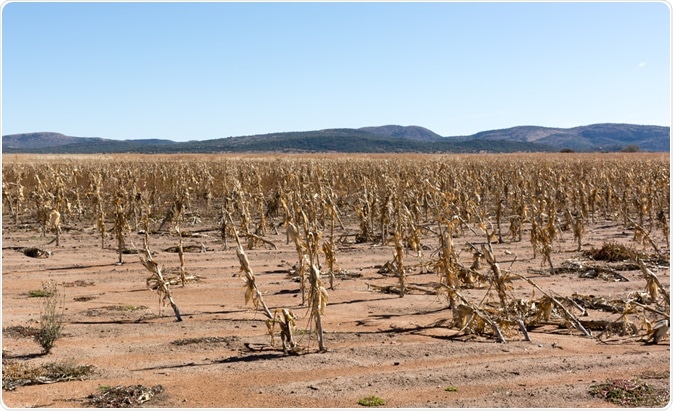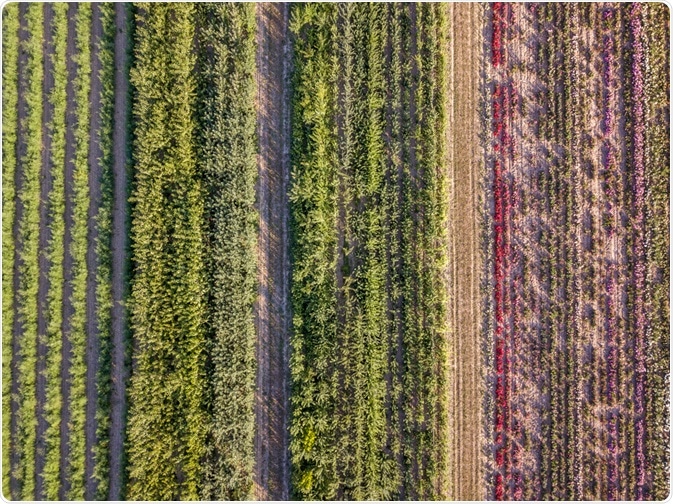With the advent of global climate change, the availability, quality, and sustainability of crop supplies around the world are predicted to decline. Crop production will be less stable under future environmental conditions, particularly with the increase in frequency and severity of droughts as seen in the past decade.

Crop Loss. Image Credit: Wildeside/Shutterstock.com
Crop Losses
Accordingly, policies preventing such major crop losses are being developed. These strategies rely on improving trade between countries and using food subsidies to mitigate national level impacts, as well as attempting to increase overall crop production. The latter can be done through several measures including the use of drought-resistant crop varieties to compensate for potential yield losses. Although such strategies may be of limited effectiveness when used in isolation, the combination of measures may ameliorate the stability of crop production.
However, these measures are also context-dependent, and may vary in success across geographic regions, socioeconomic status as well as forecasted changes under future climate change.
To further increase the susceptibility of crop losses, global agricultural systems encompass a limited number of crop species and variants, highlighted by the fact that wheat and rice alone represented 18.3 and 18.9% respectively of the world’s human calorie intake in 2013.
Such reduced diversity and widespread dependence on few crop types may lead to greater levels of instability in crop production under future environmental conditions.
Greater diversity in crop systems reduces the susceptibility to yield loss as disruptions in conditions, including temperature, precipitation, or aridity may not affect all crop types and variants similarly. Contrastingly, limited diversity will result in widespread losses of crops since the same species will experience similar impacts.
One particularly promising strategy utilizes the diversity-stability hypothesis. Specifically, the hypothesis states that increasing the diversity of crop species or crop groups will stabilize year-to-year fluctuations in yield. This strategy may be particularly successful due to the limited diversity of crop systems currently used around the world.
A study published in June 2019 authored by Delphine Renard and David Tilman from the University of Santa Barbara revealed the effectiveness of increasing crop system diversity to improve the long-term stability of crop production.
The researchers collected a comprehensive data set of national yield data between 1961 and 2010 of 176 crop species spanning 91 countries. Crop diversity over time was examined by combining a species diversity index with environmental data to generate a model of best fit which was then combined with socioeconomic and geographic data to provide insight into large-scale temporal variations of crop diversity.
In essence, results showed robust evidence supporting the diversity-stability hypothesis, demonstrating that increasing crop yield diversity led to more stable crop systems over time.
The models developed in this study also suggested that increasing crop group diversity is more effective in stabilizing yield compared to increasing crop type diversity. This may be due to the fact that crop rotations, which are common practice among agricultural systems, include more crop groups and increase overall yields.
Moreover, other factors considered in this study such as irrigation measures helped stabilize yield, whereas nitrogen fertilization did not significantly affect yield variation over time. However, these measures are known to increase crop reserves, and therefore may be used in conjunction with other solutions to stabilize overall crop production.
Incorporating additional factors may improve the fit of models to determine yield variations over time, ultimately aiming to develop predictive models to estimate long term variations. For instance, the impact of pests and pathogens, as well as changes in conditions modifying optimal ranges of crops in the future, may be collected to improve the precision of predictive models.
Importantly, this study provided extensive support for increasing diversity in crop type and crop group, which will improve the resilience of overall crop production to overcome environmental and socioeconomic challenges.
A key aspect that was not highlighted in this study but of considerable interest to investigate further is to determine whether crop diversity may affect levels of nutrition, crop affordability, and production sustainability across regions.
Indeed, increasing the diversity of crop systems enhances the resiliency of agricultural yields but could also be used to expand the dietary range of populations and provide more affordable alternatives to the most common crop types. This may be done using different crop types as well as different crop variants of each type.
Crop system diversity, therefore, provides useful insight into the potential solutions for growing populations looking into the future. Not only is diversity associated with improved yield stability as shown in the discussed findings but could also be of interest to address consumer demand.

Crop Diversity. Image Credit: Pixeljoy/Shutterstock.com
Looking to the future
Further research may be necessary to elucidate the cost-effectiveness of increasing crop system diversity, and how applicable such measures are for certain populations, particularly in regions that experience frequent food-deprivation.
In an era dominated by rapid population growth and expansion as well as changing environmental conditions, it is essential to identify effective action plans to maintain stable food supplies.
References:
- Renard, D., and Tilman, D. (2019) ‘National food production stabilized by crop diversity’, Nature, 571(7764), pp. 257–260. doi: 10.1038/s41586-019-1316-y.
- FAO STAT (Food and Agriculture Organization of the United Nations, 2018)
- Rippey, B. R. (2015) ‘The U.S. drought of 2012’, Weather and Climate Extremes, 10, pp. 57–64. doi: doi.org/10.1016/j.wace.2015.10.004.
Further Reading
Last Updated: Dec 15, 2020